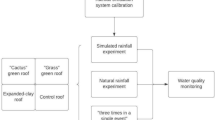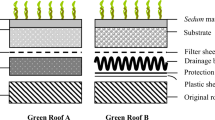Abstract
Green roofs have attracted a lot of attention from architects and engineers based on the benefits associated with their use. This research was carried out in a Brazilian semiarid region, where water is first needed for drinking and food preparation. This paper investigates the water quality drained from two green roof systems and one roof with tiles; the physical–chemical parameters were investigated. Rainwater and water percolating separately through each portion of the substrate were analysed. The results show that the water that drains from green roofs has undergone major changes in its parameters, compared to water draining from the conventional roof. It was observed that the change in water quality parameters depends on the vegetation used. In comparison with national standards for water reuse, it was concluded that the water from the green roofs was not suitable for non-potable uses, such as landscape irrigation and toilet flushing.






Similar content being viewed by others
Data availability
The authors declare that the data supporting the findings of this study are available within the article.
References
ABNT - Brazilian Association of Technical Standards (1997) NBR 13,969 - Septic tanks - Complementary treatment units and final disposal of liquid effluents - Design, construction and operation (in Portuguese)
ABNT - Brazilian Association of Technical Standards (2007) NBR 15,527 – Rainwater - Use of water from roofs in urban areas for non-potable purposes – Requirements (in Portuguese)
Almeida OA (2010) Water Quality for Irrigation. Embrapa: Cruz das Almas – Brazil. (in Portuguese)
Antas FPS (2011) Avaliação da Composição Iônica e Aplicação de um Índice de Qualidade para Água de Irrigação no Rio Açu, RN. 2011. 67 f. Dissertation of Irrigation and Drainage of Federal and Rural University of Semiarid. Rio Grande do Norte (in Portuguese)
Ayers RS, Westcot DW (1999) A qualidade da água na agricultura. Estudos FAO: Irrigação e Drenagem, 29, 2. ed, Campina Grande, UFPB 145p (in Portuguese)
Bang J, Hesterberg D (2004) Dissolution of trace element contaminants from two coastal plain soils as affected by pH. J Environ Qual 33(3):891–901. https://doi.org/10.2134/jeq2004.0891
Beecham S, Razzaghmanesh M (2015) Water quality and quantity investigation of green roofs in a dry climate. Water Res 70:370–384. https://doi.org/10.1016/j.watres.2014.12.015
Berndtsson JC (2010) Green roof performance towards management of runoff water quantity and quality: a review. Ecol Eng 36:351–360. https://doi.org/10.1016/j.ecoleng.2009.12.014
Bianchini F, Hewage K (2012) Probabilistic social cost-benefit analysis for green roofs: a lifecycle approach. Build Environ 58:152–162. https://doi.org/10.1016/j.buildenv.2012.07.005
Chandegara VK, Varshney AK (2013) Aloe vera L. processing and products: a review. Int J Med Arom Plants 3(4):492–506
Clark MJ, Zheng Y (2014) Fertilizer rate and type affect sedum-vegetated green roof mat plant performance and leachate nutrient content. HortScience 49(3):328–335. https://doi.org/10.21273/HORTSCI.49.3.328
Delatorre-Herrera J, Delfino I, Salinas C, Silva H, Cardemil L (2010) Irrigation restriction effects on water use efficiency and osmotic adjustment in aloe vera plants (Aloe barbadensis Miller). Agric Water Manag 97:1564–1570
Dimitrijevi DG, Živkovi PM, Stojiljkovi MM, Todorovi MN, Spasi-Djordjevi SZ (2016) Green living roof implementation and influences of the soil layer on its properties. Therm Sci 20(5):S1511–S1520. https://doi.org/10.2298/TSCI16S5511D
Fabricante JR, Andrade LA, Marques FJ (2010) Caracterização populacional de Melocactus zehntneri (Britton & Rose) Luetzelburg (Cactaceae) ocorrente em um inselbergue da Caatinga paraibana. Revista Biotemas 23(1):61–67 (in Portuguese)
Fan P, Wang K-l (2011) Evaluation of cold resistance of ornamental species for planting as urban rooftop greening. For Study China 13:239–244. https://doi.org/10.1007/s11632-011-0305-5
Farias MMEW (2012) Aproveitamento de águas de chuva por telhados: aspectos quantitativos e qualitativos. Dissertation of Civil Engineering Post-Graduation Program of Federal University of Pernambuco 115. https://repositorio.ufpe.br/handle/123456789/10410 (in Portuguese)
Farrell C, Szota C, Williams NSG, Arndt SK (2013) High water users can be drought tolerant: using physiological traits for green roof plant selection. Plant Soil 372:177–193. https://doi.org/10.1007/s11104-013-1725-x
Huang J, Ji M, Xie Y, Wang S, He Y, Ran J (2016) Global semi-arid climate change over last 60 years. Clim Dyn 46:1131–1150. https://doi.org/10.1007/s00382-015-2636-8
Klein PM, Coffman R (2015) Establishment and performance of an experimental green roof under extreme climatic conditions. Sci Total Environ 512–513:82–93. https://doi.org/10.1016/j.scitotenv.2015.01.020
Liu C, Dang X, Mayes MA, Chen L, Zhang Y (2017) Effect of long-term irrigation patterns on phosphorus forms and distribution in the brown soil zone. PLoS ONE 12(11):e0188361. https://doi.org/10.1371/journal.pone.0188361
Meulenbelt J (2012) Ammonia. Medicine 40(2):94–95. https://doi.org/10.1016/j.mpmed.2011.11.006
Moran A, Hunt B, Jennings G (2004) A North Carolina field study to evaluate green roof runoff quantity, runoff quality, and plant growth. In: Proceedings of the 2nd North American green roof conference: greening rooftops for sustainable communities, Portland, OR, 2–4 June 2004. The Cardinal Group, Toronto, pp 446–460
MS - Ministry of Health (2011) Ordinance No. 2914. https://bvsms.saude.gov.br/bvs/saudelegis/gm/2011/prt2914_12_12_2011.html (in Portuguese)
Moura MSB, Galvíncio JD, Brito LTL, Souza LSB, Sá IIS, Silva TGF (2007) Clima e água de chuva no Semi-Árido. In: Potencialidades da água de chuva no Semi-Árido brasileiro. Embrapa/CPATSA 34–59. https://www.alice.cnptia.embrapa.br/alice/ bitstream/doc/157643/1/Brito.Livroaguachuva.pdf (in Portuguese)
Rizwan AM, Dennis YCL, Liu C (2008) A review on the generation, determination and mitigation of Urban Heat Island. J Environ Sci 20:120–128. https://doi.org/10.1016/S1001-0742(08)60019-4
Rodriguez RDG, Pruski FF, Singh VP (2016) Estimated per capita water usage associated with different levels of water scarcity risk in arid and semiarid regions. Water Resour Manag 30:1311–1324. https://doi.org/10.1007/s11269-016-1236-7
Santos SM, Montenegro SMGL, Araújo Filho PF, Cabral JJSP, Araújo TF (2009) Determinação da utilidade do uso de telhado verde no Agreste Pernambucano. In: Proceedings of V Encontro Nacional e III Encontro Latino-Americano sobre Edificações e Comunidades Sustentáveis. Recife-PE, Brazil (in Portuguese)
Santos SM, Silva JFF, Santos GC, Macedo PMT, Gavazza S (2019) Integrating conventional and green roofs for mitigating thermal discomfort and water scarcity in urban areas. J Clean Prod 219:639–648. https://doi.org/10.1016/j.jclepro.2019.01.068
Sengupta P (2013) Potential health impacts of hard water. Int J Prev Med 4(8):866–875
Snyman HA (2014) Influence of Water Stress on Root development of opuntia ficus-indica and O. robusta. Arid Land Res Manag 28:447–463
Souza IA, Azevedo JRG, Maciel Netto A, Antonino ACD (2006) Implicações do Aquecimento Global no Balanço Hídrico Climático no 625 Agreste de Pernambuco. In: Proceedings of CBMET, Edição XIV. Florianópolis- 626 SC, Brazil (in Portuguese)
Sukreeyapongse O, Holm PE, Strobel BW, Panichsakpatana S, Magid J, Hansen HC (2002) pH-dependent release of cadmium, copper, and lead from natural and sludge-amended soils. J Environ Qual 31(6):1901–1909
Ventura AC, Andrade JCL (2011) Polyculture in the semi-arid regions of Brazil. Field Actions Science Reports, Special Issue 3. http://journals.openedition.org/factsreports/2557
Vijayaraghavan K, Raja FD (2014) Design and development of green roof substrate to improve runoff water quality: plant growth experiments and adsorption. Water Res 63:94–101. https://doi.org/10.1016/j.watres.2014.06.012
Walton NRG (1989) Electrical conductivity and total dissolved solids—what is their precise relationship? Desalination 72(3):275–292. https://doi.org/10.1016/0011-9164(89)80012-8
WHO – World Health Organization (2003) Chloride in drinking-water. Background document for preparation of WHO Guidelines for drinking-water quality (WHO/SDE/WSH/03.04/3). Geneva, World Health Organization
WHO – World Health Organization (2005) Nutrients in Drinking Water 196. https://www.who.int/water_sanitation_health/dwq/nutrientsindw.pdf
Zheng H, Wisedchaisri G, Gonen T (2013) Crystal structure of a nitrate/nitrite exchanger. Nature 497:647–651. https://doi.org/10.1038/nature12139
Acknowledgements
The authors would like to thank FACEPE (Fundação de Amparo a Ciência e Tecnologia do Estado de Pernambuco, an agency of the state of Pernambuco for post-graduate education), and CNPq (Conselho Nacional de Desenvolvimento Científico e Tecnológico, the National Counsel of Technological and Scientific Development) and PROPESQI/UFPE (Processo No. 23076.041635/2020-55-Edital Propesqi No. 07/2020) for financial support.
Author information
Authors and Affiliations
Corresponding author
Ethics declarations
Conflict of interest
On behalf of all authors, the corresponding author states that there is no conflict of interest.
Additional information
Publisher's Note
Springer Nature remains neutral with regard to jurisdictional claims in published maps and institutional affiliations.
Rights and permissions
About this article
Cite this article
dos Santos, S.M., Marinho, É.P., Lima, G.C.d. et al. Green roof drained rainwater quality assessment: a physicochemical analysis from a case study in Northeastern Brazil. Sustain. Water Resour. Manag. 8, 106 (2022). https://doi.org/10.1007/s40899-022-00698-x
Received:
Accepted:
Published:
DOI: https://doi.org/10.1007/s40899-022-00698-x




